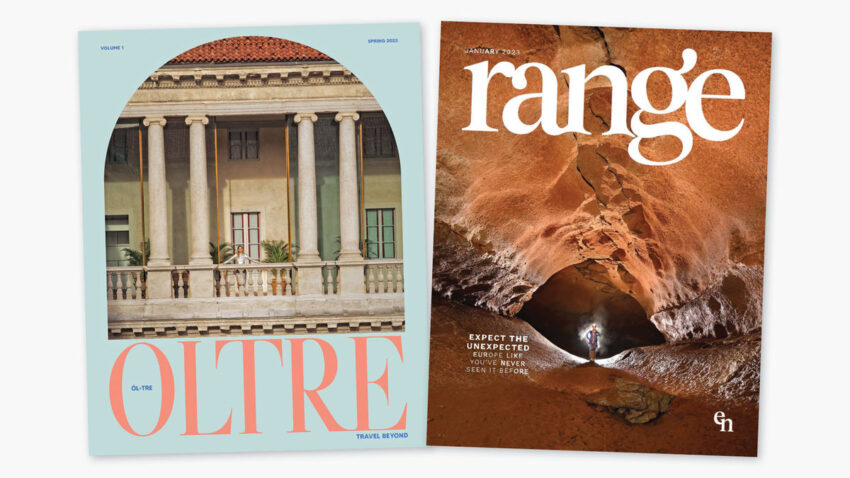In a blast from the marketing past, two major agency groups have launched consumer-facing print publications this year targeted at their top clients.
The magazines, from Ensemble and Internova Travel Group, are also emblematic of an increasing diversification of marketing from digital to more tangible forms.
Digital marketing is clearly the primary way most travel agencies reach their clients — Travel Weekly’s 2022 Travel Industry Survey found that email, websites and free social media were advisors’ top three sales and marketing channels. But executives at both agency groups said that these print investments elevate their brands, and advisors, in the eyes of travelers.
“Just having something tangible is a distinguishing differentiator from a lot of other businesses,” said Elaine Srnka, senior vice president of editorial for Internova. “I don’t know about you, but when I get a catalog in the mail from a brand that I care about, it is like a little treat. I think more and more businesses are going to email marketing, and I think that this is just an opportunity to make ourselves stand out.”

Sydney Loney, editorial director of Ensemble’s Range magazine, also said that print offers a unique way for a brand to stand out in consumers’ eyes.
“It’s that wonderful, physical embodiment of our authority, our expertise in the travel industry. Digital’s amazing, and in tandem they do so much together, but that sort of tangible thing that people get — they feel like they’re really receiving something special.
“And that’s something that you can’t get anywhere else, except through print.”
Marketers in all fields are looking to diversify the channels they use to reach consumers, especially as challenges associated with the digital environment grow, such as spam filters and the so-called digital fatigue that comes from more hours looking at screens for work and leisure.
A 2022 Forrester report commissioned by direct-mail firm PFL found that 76% of marketers surveyed agreed that engagement with digital touchpoints was waning, and 78% saw analog touchpoint engagement increasing.

Laura Sport, Internova’s vice president of publishing, said it’s important to be in front of consumers in different ways.
“Someone who’s on their computer all day long, they’re certainly not going to want to spend a lot of time reading through their email,” she said.
And while email marketing is very useful in getting advisors’ names in front of clients regularly, Sport said, “with the print product, you can really sit down and spend time with it, some quality time, reading through and formulating your ideas for what you want to have your next travel look like.”
‘A gift’ for clients
In addition to the quarterly Range, which has a print circulation of 50,000 to 75,000 depending on the issue, Ensemble launched some complementary publications. Range Best will be published six times a year and offers ideas, promotions and offers from preferred suppliers. Ensemble will also offer directory products, the first of which focuses on cruising and is called Range by Sea. A hotel-focused directory will come out later this year.

The publications replace several print marketing pieces Ensemble had used in the past, said Shahla Lalani, senior vice president of marketing, and they also have digital components.
Ensemble is working with members to determine which clients receive print products, but generally speaking, they are the top ones, Lalani said. The consortium is in the process of segmenting members’ clients into profiles to target the publications.
Loney described the flagship Range as “that coveted quarterly magazine.”
“We see it as a sort of a gift that arrives in our clients’ mailboxes,” she said. “It’s full of the tools they need, lush photography, some of the best storytelling.”
Beyond a sales tool for advisors
Internova’s quarterly magazine, Oltre, began making its way into consumer mailboxes this month and is targeted at customers of Internova’s luxury division, Global Travel Collection (GTC). Like Range, it also has a digital presence.

Srnka, who said GTC didn’t previously do any print mailings, said a print magazine is a “luxury product.”
Oltre is printed on a heavier stock of paper, she said, and is called a “volume,” not an issue, “to indicate the collectible, keepsake nature of each one.”
As such, it’s aimed at GTC’s top clients.
“We tried to cherry-pick who was going to be receiving it, because the purpose of it, of course, is a touchpoint with the consumers,” Srnka said. “So to thank them for their business, but to inspire them like, ‘Oh, hey, I would like to do this Antarctica cruise. I’m going to call my travel advisor and ask her about it.’ It’s not altruistic. It is meaningful information and inspiration for the consumer, but it’s a long-tail sales tool.”
With a print circulation of 100,000, Oltre is an investment, Srnka said.
“But it’s a quarterly, so we’re easing into it,” she said. “It’s an investment, but I don’t think we’re throwing money away at all.”
Internova’s ambitions with Oltre are also greater than a marketing tool for advisors. In the next five years, Sport plans to position it as a paid consumer magazine.
“We did not launch this magazine to just stay within the Global Travel Collection universe,” Sport said. “It will always be there. We will always have the Global Travel Collection client receive this magazine. But our plans are bigger than that, which is to be a travel publication on the newsstand.”
